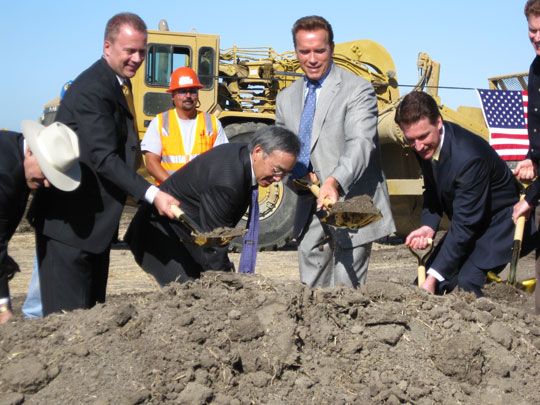
There were shovels and dirt. Gov. Schwarzenegger and Energy Secretary Steve Chu. And a pre-Labor Day fanfare to make the point that a hefty investment of public money in a startup solar panel company will create jobs and more jobs.
Solyndra held a ground-breaking ceremony Friday morning for its second factory (Fab 2) complex less than a mile from its headquarters in Fremont, Calif.
The company has garnered a lot of attention not only for its unusual solar panel design, but also for being the first company to receive a U.S. Department of Energy Loan guarantee funded by the American Recovery and Reinvestment Act.
"If you build a better solar panel, then the world will beat a path to your door," Chu said.
In fact, the loan guarantee is the first from the DOE since the 1980s, said Chu on stage. Chu first announced the $535 million loan guarantee in March this year, but it wasn't until recently that the DOE and Solyndra finalized the details of the financial arrangement.
With this financial help, the Obama administration is casting Solyndra as a role model for its efforts to pump up the economy. Every speaker at the ground breaking ceremony, including Vice President Joe Biden, who spoke via satellite, talked about same two things: jobs and clean energy.
The factory construction should generate jobs for about 3,000 people. The factory itself will provide over 1,000 jobs, the company said.
Schwarzenegger offered this zinger: "We are here to say, 'Hasta la vista, global warming!' "
With the loan guarantee, Solyndra is borrowing the money from the U.S. Treasury's Federal Financing Bank. The company also raised $198 million in an equity round led by Argonaut Private Equity for building Fab 2, Solyndra said Friday.
Fab 2 would be large enough to eventually accommodate an annual production capacity of 500 megawatts of panels. Building this factory is crucial for Solydra to deliver on roughly $2 billion worth of contracts to customers in the United States and Europe. Its customers include GeckoLogic, Phoenix Solar and Carlisle Energy Services.
"We are agents of change," said Solyndra CEO Chris Gronet during his turn at the podium. "We'll make a difference one cell at a time, one module at a time, one gigawatt at a time."
The company, founded in 2005, began commercial production last summer. Its first factory complex has equipment to produce 200 megawatts of solar panels.
Solyndra's solar panel design has attracted both fascination and skepticism. Instead of a flat surface like a conventional solar panel, Solyndra's involves a series of solar-cell filled tubes lying side by side inside an aluminum frame.
The cylindrical design enables solar cells to capture diffused and reflected light, the company said. Solyndra, which also has designed a low-profile rack to hold the panels, is targeting the commercial rooftop market. The panel-and-rack design shaves labor time and costs, the company said.
The solar cells use a compound of copper, indium, gallium and selenium (CIGS) for converting sunlight into electricity. The use of these materials also is fairly new for the market, which is dominated by cells made with silicon.
Its fellow CIGS companies include Nanosolar, Miasole and Heliovolt. But none has garnered the spotlight or announced the huge contracts like Solyndra has.
Incidentally, Nanosolar also is poised to make some big announcement next week. The San Jose, Calif., startup took down its website earlier this week.

Gov. Schwarzenegger and Energy Secretary Steve Chu break ground with Solyndra execs.
Pictured above: Chris Gronet, CEO of Solyndra (left), Energy Secretary Chu (middle), and Ben Bierman, VP of global operations at Solyndra (right).
Solyndra executives take Energy Secretary Chu on a factory tour.